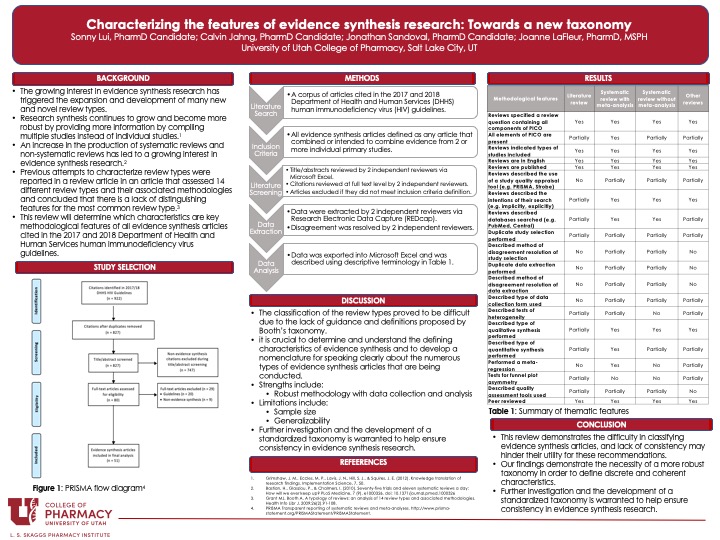Sonny
Characterizing the features of evidence synthesis research: Towards a new taxonomy
April 28, 2020 in College of Pharmacy, Virtual Poster Session Spring 2020

Purpose: Clear communication in medical science is essential to interpret research findings accurately. In evidence synthesis, considerable ambiguity exists in the authors’ terminology related to a variety of methodological approaches. Our goal is to characterize the range of various methodologies by identifying critical features of evidence synthesis articles among a corpus of such articles cited in the 2017 and 2018 Department of Health and Human Services (DHHS) human immunodeficiency virus (HIV) guidelines, with the goal of developing a new taxonomy for evidence synthesis.
Methods: All evidence synthesis articles cited in the 2017 and 2018 DHHS HIV guidelines were included. An evidence synthesis article was broadly defined as an article that combined or intended to combine evidence from 2 or more individual primary studies. Evidence synthesis articles were in the title/abstract review by two independent investigators, with disagreement being resolved by a third investigator. For articles that could not be classified based on title/abstract review, a full text was also performed. The identified articles were then classified using an existing classification system based on Booth’s taxonomy. Data were also collected about specific features of each evidence synthesis type, such as exposure types, outcome types, search methods, and synthesis methods. The evidence synthesis articles were grouped into like categories based on specific feature types in order to assess the prior classification system. The identified methodological features were described based on review types shown in Table 2.
Results: A total of 922 evidence synthesis articles were cited by the 2017-2018 guidelines, including 28 literature reviews, eight systematic reviews, eight meta-analyses, and three systematic reviews with a meta-analysis. No review type could be identified to classify 12 of the 51 included articles, suggesting a need for a new taxonomy.
Conclusion: In conclusion, we have determined there is a variance in the diverse array of evidence synthesis article types with in the 2017 and 2018 DHHS guidelines that were not able to be adequately characterized by Booth’s taxonomy.
